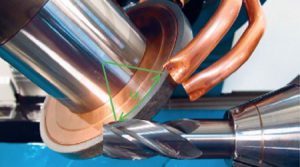A few simple rules for grinding
Grinding is a manufacturing process that is often left up to a designated, experienced grinding expert in a workshop.
Why can’t any other machine operator perform this work? Certain basic rules must to be observed during grinding, just like milling. The grinder has to know which material can be machined with which tool. And just like milling, the grinder also has to know which feed rates, infeeds and speeds are allowed on his machine for the material being processed.

The materials
The most common materials for grinding are hard metals (carbides embedded in metallic cobalt-, sometimes also nickel- and chrome-matrix). These are followed by tool steels, made by hardening (HSS) or powder metallurgy processes (PM). Other materials that are ground, but more rarely, include ceramics (Al2O3, ZrO2, Cermets), various glasses, titanium alloys (Ti5Al2 – turbine manufacture, implants), CBN (cubic boron nitride), crystalline or polycrystalline diamonds and other precious stones.
The grinding tools and/or wheels consist of hard abrasive grits embedded in bonds that are stuck to the disc bodies. The most commonly used tools are diamond wheels for machine hard metals (and all extremely hard materials that do not contain carbon) and CBN grinding wheels to machine hardened steels.
The so-called conventional grinding wheels consist of ceramic disc bodies in which corundum or silicon carbide are bonded as abrasive grit. These are used to machine steels and hardened steels.
CBN (5000 VH) is the second hardest material after diamond (8000 VH). By comparison, silicon carbide has a Vickers hardness of 3500, aluminium oxide and corundum around 2100. Diamond is not a suitable abrasive for steel since this abstracts carbon atoms from the diamond structure under the mechanical and thermal effects of grinding.
Cooling
Since grinding is not just a chip removal but also a frictional process, a large part of the energy is converted into heat. The added coolant has 3 jobs: to cool the grinding zone, reduce the frictional forces during grinding through lubrication and to rinse away the cutting residues. Just how well these 3 tasks are performed depends on the direction, quantity (amount and pressure) and quality of the coolant.
Most of today’s grinding applications are cooled by oils: although their thermal dissipation properties are poorer than emulsions, the advantages prevail. And machine maintenance is a lot easier with grinding oil.
One basic rule for the orientation of the coolant nozzle: the tangential inlet on the periphery of the grinding wheel should be at an angle of 20 to 30 degrees in front of the grinding zone (see angle α in the figure). To ensure the optimum entrainment of the coolant, its inlet velocity has to be the same as the peripheral velocity.
The coolant distributing plates of a NORMA CFG with 3 outlets per valve lead to an estimated exit velocity of 15 to 18 m/s, if the 3 connections are made with copper pipes – and using a 6 bar pump. With 2 copper pipes the estimated velocity is 20 to 24 m/s, with one copper pipe 26 to 31 m/s. If this one outlet is constricted (interior diameter from 8 to 6 mm), the velocity increases by approx. 2 to 4 m/s.
The velocity is calculated on the basis of a pressure measurement in the distributing block and the application of the «Bunsen’s emission law» and factorisation with a velocity figure and contraction factor.
A 10 to 12 bar pump should be used if a cutting rate of 40 or more is necessary in the grinding process.
The figure below shows a well-adjusted cooling using simple means for deep groove grinding:
Quantification of the grinding process
Using this knowledge, we can mount a grinding wheel on a high-precision wheel adaptor with a well-adjusted coolant feed in the grinding spindle and start our grinding process. We now discover that the set feed rate leads to an unexpectedly high power input. The discolorations on the coating indicate that only a fraction of the coating was in use. Numerous grinding processes can be greatly improved by trimming the wheel in the machine. One also speaks of dressing the grinding wheel – restoring the concentricity of a 1A1 by oscillating a Sic wheel 20 to 30 times with a 0.01 mm radial feed movement per stroke.
We are now ready for our grinding process, for example deep groove grinding with a helical milling cutter or drill. How do we know that the pre-set feed rate is the correct one?
The stock removal rate of a grinding process is quantified with the specific material removal rate Q’w. This is the amount of material removed per unit of time and relative to the contact width of the grinding wheel (active width of the wheel coating). The simple grinding process of surface grinding (straight grove with a depth of ae in a plate) has the following formula
A feed rate can be easily calculated if one knows a value for a reasonable specific material removal rate from experience or from the manufacturer of the grinding wheel.
An ambitious Q’w value for CBN is 6–10, which wit a groove depth of 3 mm results in a feed rate of 120–200 [mm/min].
The Q’w value for deep spiral grooves cannot be calculated on the basis of a simple formula for straight grooves. The geometric conditions are similar, but the disc width no longer correlates to the active contact length in the groove cross-section. The inclined position of the grinding wheel means that a lateral part of the coating becomes active. The calculation, which is generally applied very strictly, hereby leads to overestimated values. This is just one indication that Q’w-W values cannot always be generally compared, whereas comparisons of the same application on different materials with different parameters may by all means be sensible.
Deep groove grinding in hard metal using grinding wheels with «metal hybrid» bonds today achieves Q’w values of between 7 and 18 [mm2/s].
The experienced grinder could have told you from the very start that this groove can be ground well with a feed rate of 65 mm/min. (Ø 20 mm, spiral angle 30º, groove depth 4,2 mm). He how has some instruments at his disposal to quantify his intuitive know-how. The inexperienced grinder can practice grinding with these few basic rules.
